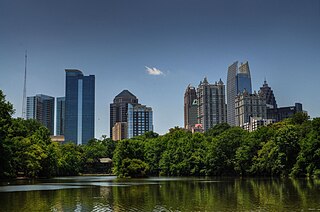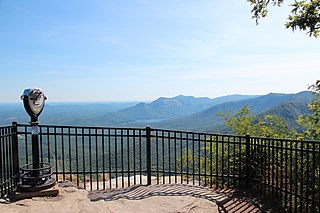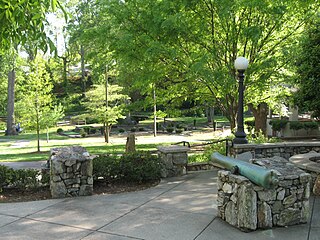
Cleveland Park is the largest park in Greenville, South Carolina, much of its more than 120 acres being greenway along Richland Creek and the Reedy River near the city's "most elegant neighborhoods." [1]

Greenville is a city in and the seat of Greenville County, South Carolina, United States. The city's mayor is Knox H. White, who has been in that position since December 1995. With an estimated population of 68,219 as of 2017, it is the sixth-largest city in the state. The population of the surrounding area was 400,492 as of 2010, making it the third-largest urban area in South Carolina as well as the fastest growing. Greenville is the largest city in the Greenville-Anderson-Mauldin Metropolitan Statistical Area. The MSA had a population of 906,626 in 2018, making it the largest in South Carolina and the third largest in the Carolinas.
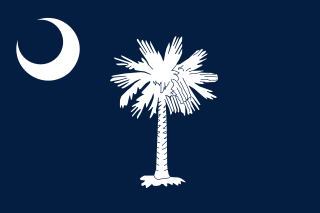
South Carolina is a state in the Southeastern United States and the easternmost of the Deep South. It is bordered to the north by North Carolina, to the southeast by the Atlantic Ocean, and to the southwest by Georgia across the Savannah River.
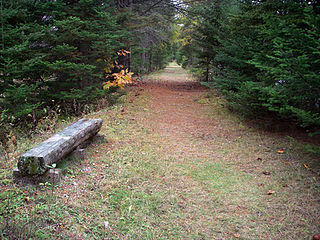
A greenway is "a strip of undeveloped land near an urban area, set aside for recreational use or environmental protection". However, the term can in fact include "a scenic road" and though many are in urban areas, there are some rural greenways, as for example the Monadnock-Sunapee Greenway, a hiking trail in southern New Hampshire.
On December 31, 1924, with encouragement from Greenville Park Commission chairman John Alexander McPherson, prominent Greenvillean William Choice Cleveland donated a crescent-shaped 110 acres on the southeast side of town to be used as a park and playground, a recreational area he hoped would complement his new housing development, Cleveland Forest, and would include an equestrian park and paddocks where residents could board their horses. [2] (Stables managed by private owners existed adjacent to the park until they were demolished in 2014.) [3] In 1925, the city of Greenville created two baseball fields, a horse ring, and a playground, and the park officially opened on January 1, 1926. [4]
By 1928, during the administration of Mayor Richard Watson, [5] when a $110,000 bond issue to develop the park was approved, the park was surveyed at 126 acres. Land around the river was boggy and prone to flooding, a deficiency partially remedied during the Great Depression when the WPA channelized the river bed, greatly improving drainage. [6]

The Great Depression was a severe worldwide economic depression that took place mostly during the 1930s, beginning in the United States. The timing of the Great Depression varied across nations; in most countries, it started in 1929 and lasted until the late 1930s. It was the longest, deepest, and most widespread depression of the 20th century. In the 21st century, the Great Depression is commonly used as an example of how intensely the world's economy can decline.

The Works Progress Administration was an American New Deal agency, employing millions of job-seekers to carry out public works projects, including the construction of public buildings and roads. It was established on May 6, 1935, by Executive Order 7034. In one project, Federal Project Number One, the WPA employed musicians, artists, writers, actors and directors in large arts, drama, media, and literacy projects. The five projects dedicated to these were: the Federal Writers’ Project (FWP), the Historical Records Survey (HRS), the Federal Theatre Project (FTP), the Federal Music Project (FMP), and the Federal Art Project (FAP). In the Historical Records Survey, for instance, many former slaves in the South were interviewed; these documents are of great importance for American history. Theater and music groups toured throughout America, and gave more than 225,000 performances. Archaeological investigations under the WPA were influential in the rediscovery of pre-Columbian Native American cultures, and the development of professional archaeology in the US.
In its earliest years the park included a Girl Scout meeting place and a nine-hole public golf course, built and abandoned in the 1930s. [7] A swimming pool and skating rink were added in 1929; but in 1964, during the Civil Rights Movement, the whites-only pool was closed to prevent it from being integrated. First a sea lion exhibit replaced the pool, then a rose garden; finally in 1988, tennis courts replaced both garden and skating rink. [8] [9]

Sea lions are pinnipeds characterized by external ear flaps, long foreflippers, the ability to walk on all fours, short, thick hair, and a big chest and belly. Together with the fur seals, they comprise the family Otariidae, eared seals, which contains six extant and one extinct species in five genera. Their range extends from the subarctic to tropical waters of the global ocean in both the Northern and Southern Hemispheres, with the notable exception of the northern Atlantic Ocean. They have an average lifespan of 20–30 years. A male California sea lion weighs on average about 300 kg (660 lb) and is about 2.4 m (8 ft) long, while the female sea lion weighs 100 kg (220 lb) and is 1.8 m (6 ft) long. The largest sea lion is Steller's sea lion, which can weigh 1,000 kg (2,200 lb) and grow to a length of 3.0 m (10 ft). Sea lions consume large quantities of food at a time and are known to eat about 5–8% of their body weight at a single feeding. Sea lions can move around 16 knots in water and at their fastest they can reach a speed of about 30 knots. Three species, the Australian sea lion, the Galápagos sea lion and the New Zealand sea lion are listed as Endangered.

A rose garden or rosarium is a garden or park, often open to the public, used to present and grow various types of garden roses or rose species. Designs vary tremendously and roses may be displayed alongside other plants or grouped by individual variety, colour or class in rose beds.
In 1930, the Greenville Garden Club began to renovate a Civil-War era rock quarry into the Rock Quarry Garden. The garden won a Better Homes and Gardens award in 1932; but by the 1960s, it was neglected and overgrown. Another renovation project revitalized the garden in the 1980s, and in the 21st century, the Rock Quarry Garden became a popular wedding and reception venue. [10]

Better Homes and Gardens is the fourth best selling magazine in the United States. The editor in chief is Stephen Orr. Better Homes and Gardens focuses on interests regarding homes, cooking, gardening, crafts, healthy living, decorating, and entertaining. The magazine is published 12 times per year by the Meredith Corporation. It was founded in 1922 by Edwin Meredith, who had previously been the United States Secretary of Agriculture under Woodrow Wilson. The original name was Fruit, Garden and Home from 1922 to 1924. The name was changed in 1925 to Better Homes and Gardens.
In the 21st century, the park, now adjacent to the Greenville Zoo, included a softball field, volleyball and tennis courts, several playgrounds, a Vietnam Veterans Memorial, and eight picnic shelters. The Swamp Rabbit Trail runs through the park, and it also includes the Fernwood Nature Trail, the Ramona Graham Fitness Trail, and the Troop 19 Trail. [11] A distinctive landmark is the memorial to Rudolf Anderson, a Greenville native shot down over Cuba in October 1962, the only American casualty of the Cuban Missile Crisis. The Anderson memorial features an F-86 Sabre and panels explaining Anderson's life and mission. [12]

The Greenville Zoo is a zoo in Greenville, South Carolina, United States. The zoo opened in 1960, and is located at 150 Cleveland Park Drive, near Interstate 385, on a 14-acre (5.7 ha) site within Cleveland Park.

The Greenville Health System Swamp Rabbit Trail is a 19.9-mile (32.0 km) multi-use rail trail in Greenville County, South Carolina, that largely follows the bed of a former railroad that had been nicknamed after the indigenous swamp rabbit. South-to-north the current trail begins at Greenville Technical College, crosses the city of Greenville, proceeds through Falls Park and the campus of Furman University, and ends about a mile north of the Travelers Rest city limits.

Rudolf Anderson Jr., was a pilot and commissioned officer in the United States Air Force and the first recipient of the Air Force Cross, the U.S. Air Force's second-highest award for heroism. The only person killed by enemy fire during the Cuban Missile Crisis, Anderson died when his U-2 spy aircraft was shot down over Cuba.

